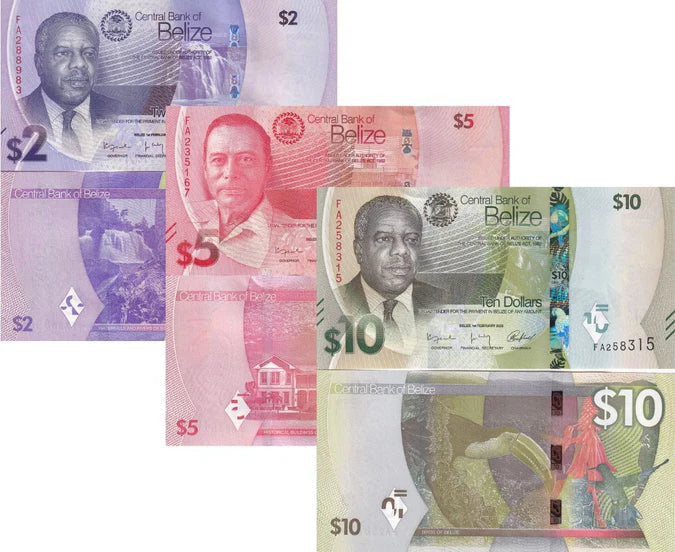Every country’s currency tells a story. It reflects not just economics, but also heritage, identity, and national pride. In Belize, the banknote is more than a means of exchange—it’s a living canvas that chronicles the country’s colonial struggles, its path to independence, and now its journey toward celebrating local heroes. The 2025 banknote redesign marks one of the most symbolic changes in Belize’s monetary history, replacing the monarchy with images of Belizean national heroes. To appreciate the significance of this transformation, let’s explore the fascinating history of Belize’s currency and the story behind its new look.
The Currency Through the Ages
Colonial Era: The British Honduras Dollar
Before Belize was known by its modern name, it was called British Honduras. During the 19th century, the region used a mixture of Spanish, Central American, Guatemalan, British, and U.S. coins. In 1894, the first official banknotes of British Honduras were introduced, establishing the British Honduras Dollar, divided into 100 cents.
These early notes carried strong colonial influence, including the portrait of the reigning British monarch. This connection to Britain remained a hallmark of Belizean banknotes for nearly a century.

Transition to Independence
As Belize moved closer to independence, its currency began to shift in identity. In 1974, the first notes bearing the name Belize were printed, in denominations of $1, $2, $5, $10, and $20. Shortly after, the Monetary Authority of Belize was established in 1976, issuing the first $100 banknote in 1980.
The Central Bank of Belize was created in 1982, and by 1983, new banknotes were issued under its name. These designs introduced vibrant depictions of local wildlife, marine life, and architecture while continuing to feature Queen Elizabeth II’s portrait.
Over time, adjustments were made: the $1 note was replaced by a coin in 1990, and commemorative editions were issued, such as the 2012 $20 note marking the Central Bank’s 30th anniversary.

The 2025 Redesign: A Symbol of National Identity
In January 2025, Belize took a historic step by unveiling a new series of banknotes. Unlike previous designs, these notes no longer feature the image of a British monarch. Instead, the faces of Belize’s two National Heroes—George Cadle Price and Philip Goldson—take center stage.
The redesign, produced by the security printing company De La Rue, incorporates modern anti-counterfeiting features alongside national imagery. From mid-2025, denominations ranging from $2 to $100 will carry the likeness of Price and Goldson, replacing Queen Elizabeth II entirely.
The decision reflects Belize’s commitment to decolonization and cultural pride, signaling a desire to highlight the achievements of its own people rather than maintain colonial symbolism.
Spotlight on the National Heroes Featured

George Cadle Price
Widely revered as the Father of Belize’s Independence, George Cadle Price played a central role in the nation’s journey to sovereignty in 1981. A visionary leader and the first Prime Minister, Price dedicated his life to unifying Belize and ensuring its freedom from colonial rule.
In 2000, he became the first recipient of the country’s highest honor, the Order of the National Hero. Today, his image proudly appears on the $5, $20, and $100 banknotes, symbolizing his enduring legacy.
Philip Goldson
Philip Goldson was a journalist, political activist, and tireless advocate for democracy and human rights in Belize. He was instrumental in shaping the nation’s political landscape and inspiring future generations.
Goldson’s lifelong fight for justice earned him recognition as a National Hero in 2008. His portrait now graces the $2 and $50 notes, reminding Belizeans of his contributions to freedom and civic responsibility.

Belize in Historical Context
Understanding Belize’s banknote evolution requires looking at the broader story of the country itself.
-
Maya Legacy: Long before colonial rule, Belize was home to the Maya civilization, which thrived for centuries and left behind remarkable cities like Caracol and Lamanai.
-
Colonial Struggles: From the 17th century onward, Belize was a contested territory, ultimately becoming a British colony in the 1800s.
-
Independence in 1981: On September 21, 1981, Belize gained independence, though it remained a Commonwealth realm, recognizing the British monarch as head of state.
-
A Decolonial Shift: With the 2025 banknote redesign, Belize has taken a bold step in redefining its symbols of nationhood. By celebrating Price and Goldson, Belizeans are reinforcing their identity as a proud, independent nation rooted in resilience and unity.
Conclusion
The history of Belize’s banknotes mirrors the country’s broader journey—from colonial subjugation to independence and, now, to celebrating its own national heroes. By placing George Cadle Price and Philip Goldson on the 2025 series, Belize has redefined its currency as a powerful symbol of sovereignty and identity.
For collectors, historians, and Belizeans alike, these new notes are more than money—they are a proud testament to a nation that continues to honor its past while shaping its future.
Frequently Asked Questions (FAQ)
Q1: Why did Belize replace the monarch’s image on its banknotes?
Belize replaced the monarch to emphasize national pride and honor its own heroes rather than continuing colonial traditions.
Q2: When will the new banknotes be in circulation?
The new series was unveiled in January 2025 and will be introduced mid-year.
Q3: What images appear on the new notes?
The obverse features either George Cadle Price or Philip Goldson, while the reverse showcases Belizean culture, natural landmarks, and security elements.
Q4: Who was George Cadle Price?
He was Belize’s first Prime Minister and led the independence movement, making him the most revered figure in the nation’s modern history.
Q5: Who was Philip Goldson?
Goldson was a politician, journalist, and activist, remembered for his fight for democracy and social justice.

